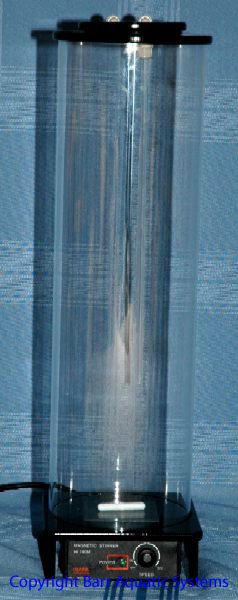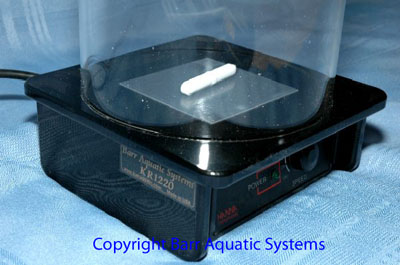Home
Advantages of Barr Systems
Pumps
Instructions
DIY Threads
Order Page
|

Kalk Reactors:
KR1020, KR1220 and KR3020
Inspection:
Inspect your new reactor closely upon receipt. Any damage must be reported to the shipper with 24 hours, or they may not cover the damage. Contact us immediately if there looks to be damage. We will repair or replace the part(s) as needed. Unfortunately we can take no action until the damage claim is validated by the shipper.
Things to look for:
- Check the box for damage before opening. Take pictures if it looks obviously holed or crushed
- Check for cracks in tubes, especially where they glue to supports or flanges.
- Check that the O-rings is in place.
- Compare the invoice to what is in the box to insure that all items shipped were received.
Installation:
Each reactor comes with a large and small stir bar (except the KR3020 series), and a 1/4" Speed-Fit for water input/output.
- There are two fittings on the top flange. One for water in and one for the mixed kalk and water out.
- Attach the water in to the fitting with the dip tube (so the fresh water is injected deep in the unit).
- Attach the output line to the to other fitting (which pulls mixed kalk/water from the top of the unit).
- It is CRITICAL that you do not obstruct the output line in any way. Using a float valve on this line will case the unit to crack or explode. It will NOT take the full water pressure from and RO/DI unit.
- See below for more setup tips.
|
 |
- Install the large stir bar to the center of the pad.
- Plug in the mixer and test it by setting the speed to 1/2. Going too fast will cause the stir bar to spin off center.
|
 |
Filling:
- Move the output line to a waste drain for testing purposes.
- Remove the twist-lock lid.
- Fill the unit 3/4 full with RO/DI water.
- Turn on the mixer to 1/2 speed.
- Using a funnel spoon in a 1/2 cup of Kalk (3 teaspoons) to start.
- Fill the rest of the unit with RO/DI water to near the top.
- Insure that no kalk got on the O-ring and install the lid.
- Allow to mix for a few minutes, then turn off.
- Test your top-off system by manually triggering it, and making sure that the water flows though the kalk system properly.
- When it all looks good, replace the output line in to you sump.
- Carefully monitor the Kalk reactor for the first few days.
- Check the pH of the effluent weekly. It should be over 12. If it is low, add more kalk.
Timers:
The Kalk units require that the stirrer be placed on a timer. The best timers are a digital timer that gives you multiple on/off times per day and minute accuracy. Set the timer to mix twice a day (say midnight and noon) for one minute. Add more mixing times if you use a lot of top off water (about 1-2 gallons per mix for the KR1020-KR1220, 3-4 gallons per mix for the KR3020.)
Never run the mixer 24 hours a day. It will prematurely wear the UHMW pad in the bottom of the unit. In normal use, the supplied pad will never wear out.
Fail safe the system:
An overdose of Kalk to a system can be fatal. Since the Kalk reactor is part of your top-off system, a failure in that system can cause a Kalk overdose. There are several steps you can take to help minimize the potential risk.
- Use a needle valve on the input. Adjust so that it barely drips faster than water evaporates. If the top-off system sticks on, you will have a day or two to notice.
- If you can't adjust the needle valve low enough, install a solenoid on a timer to the input side, so the top-off system will only come on for a few minutes every hour. If you are not getting enough water out of the system to make up for evaporation, open the needle valve a little or add more minutes to the on times.
- Clean the end of the output tube monthly. It can build up a crust of Kalk that may restrict the water flow.
- The unit may leak water past the O-ring if the output tube clogs. Place the unit such that any leaks are contained, or run down a drain.
- Don't turn the speed up so far it is on the edge of flinging the magnet off center. Stirring slower for a longer time is perfectly fine.
Maintenance:
Some brands of Kalk do not dissolve fully. Additionally Kalk can react to phosphate and metals in your water to precipitate out (a good thing). This can lead to a waste in the bottom of the unit that will never dissolve. If you have an inch of power in the unit and are not maintaining a pH of over 12, then it may be time to remove and flush the unit with fresh water. Typically this should be done every 3-6 months.
Leaks:
Occasionally a unit will weep water from the O-ring joints. This is not abnormal, and usually can be easily corrected. All units are water tested before they leave the factory so it should be possible to get it to run dry.
You can use these steps to help stop the leak.
- Make sure the unit can never be pressurized.
- Make sure the O-ring is seated, and no sand or grit is in the groove.
- Seal the O-ring with O-ring sealant, or Vaseline.
- Let it set for a few days, then snug it up again- As the O-ring seats, it seals better.
- Contact us if you cannot get it to seal or if you suspect a leak from a place that does not have O-rings.
Final Note:
Although the reactor will make adding Calcium and Alkalinity easy, its up to you to routinely test for them. As your corals grow they so will their Calcium and Alkalinity demands.
© 2004-2018 Barr Aquatic Systems. All Rights Reserved
|
|




